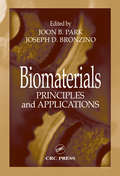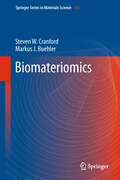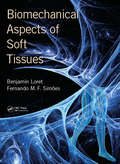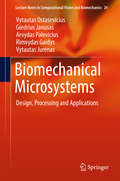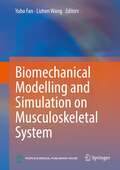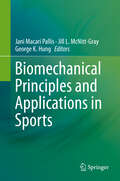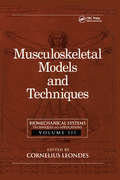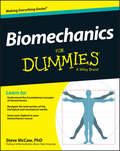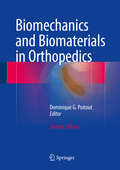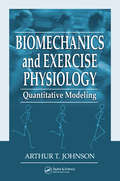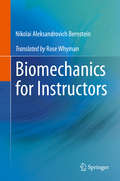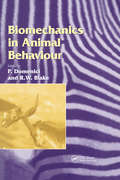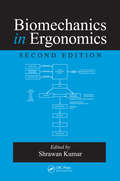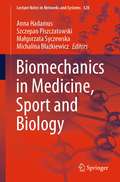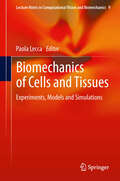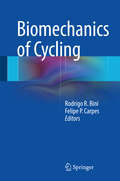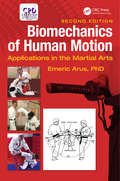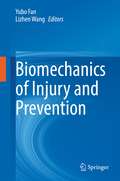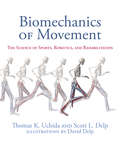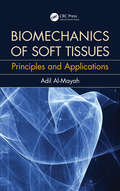- Table View
- List View
Biomaterials: A Nano Approach
by Winston O. Soboyejo Seeram Ramakrishna Murugan Ramalingam T .S. KumarThere are several well-known books on the market that cover biomaterials in a general way, but none provide adequate focus on the future of and potential for actual uses of emerging nanontechnology in this burgeoning field.Biomaterials: A Nano Approach is written from a multi-disciplinary point of view that integrates aspects of materials science a
Biomaterials: Principles and Applications
by Joseph D. Bronzino Joon B. ParkBiomaterials: Principles and Applications offers a comprehensive review of all the major biomaterials in this rapidly growing field. In recent years, the role of biomaterials has been influenced considerably by advances in many areas of biotechnology and science, as well as advances in surgical techniques and instruments. Comprising chapters
Biomaterials: Principles and Practices
by Joseph D. Bronzino Donald R. Peterson Joyce Y. WongMost current applications of biomaterials involve structural functions, even in those organs and systems that are not primarily structural in their nature, or very simple chemical or electrical functions. Complex chemical functions, such as those of the liver, and complex electrical or electrochemical functions, such as those of the brain and sense
Biomateriomics (Springer Series in Materials Science #165)
by Markus J. Buehler Steven W. CranfordBiomateriomics is the holistic study of biological material systems. While such systems are undoubtedly complex, we frequently encounter similar components -- universal building blocks and hierarchical structure motifs -- which result in a diverse set of functionalities. Similar to the way music or language arises from a limited set of music notes and words, we exploit the relationships between form and function in a meaningful way by recognizing the similarities between Beethoven and bone, or Shakespeare and silk. Through the investigation of material properties, examining fundamental links between processes, structures, and properties at multiple scales and their interactions, materiomics explains system functionality from the level of building blocks. Biomateriomics specifically focuses the analysis of the role of materials in the context of biological processes, the transfer of biological material principles towards biomimetic and bioinspired applications, and the study of interfaces between living and non-living systems. The challenges of biological materials are vast, but the convergence of biology, mathematics and engineering as well as computational and experimental techniques have resulted in the toolset necessary to describe complex material systems, from nano to macro. Applying biomateriomics can unlock Nature's secret to high performance materials such as spider silk, bone, and nacre, and elucidate the progression and diagnosis or the treatment of diseases. Similarly, it contributes to develop a de novo understanding of biological material processes and to the potential of exploiting novel concepts in innovation, material synthesis and design.
Biomechanical Aspects of Soft Tissues
by Benjamin Loret Fernando Manuel SimoesBiomechanics applies the laws and techniques of mechanics in the study of biological systems and related phenomena. Biomechanics uses mathematical and computational tools such as model construction of musclo-skeletal system, body fluid circulation, to aid medical diagnosis, therapeutics and surgery planning, designing of prostheses and implants or in tissue engineering. Present book targets specific topics pertaining to the biomechanics of soft tissues. Subjects addressed includes solids and multi-species mixtures as open systems: a continuum mechanics perspective; electro-chemo-mechanical couplings: tissues with a fixed electric charge and growth of biological tissues.
Biomechanical Basis Of Human Movement
by Timothy Derrick Joseph Hamill Kathleen KnutzenHelp your students understand the full continuum of human movement potential with the Fourth Edition of this rigorous--yet understandable--introductory text on the market. Focusing on the quantitative nature of biomechanics, Biomechanical Basis of Movement, Fourth Edition integrates current literature, meaningful numerical examples, relevant applications, hands-on exercises, and functional anatomy, physics, calculus, and physiology to help your students develop a holistic understanding of human movement. The book's chapters are essentially self-contained, allowing you maximum teaching flexibility in structuring your course. The Fourth Edition offers new content, new examples and applications, and online teaching and learning resources to save you time and help your students succeed.
Biomechanical Microsystems: Design, Processing and Applications (Lecture Notes in Computational Vision and Biomechanics #24)
by Vytautas Ostasevicius Giedrius Janusas Arvydas Palevicius Rimvydas Gaidys Vytautas JurenasThis book presents the most important aspects of analysis of dynamical processes taking place on the human body surface. It provides an overview of the major devices that act as a prevention measure to boost a person's motivation for physical activity. A short overview of the most popular MEMS sensors for biomedical applications is given. The development and validation of a multi-level computational model that combines mathematical models of an accelerometer and reduced human body surface tissue is presented. Subsequently, results of finite element analysis are used together with experimental data to evaluate rheological properties of not only human skin but skeletal joints as well. Methodology of development of MOEMS displacement-pressure sensor and adaptation for real-time biological information monitoring, namely "ex vivo" and "in vitro" blood pulse type analysis, is described. Fundamental and conciliatory investigations, achieved knowledge and scientific experience about biologically adaptive multifunctional nanocomposite materials, their properties and synthesis compatibility, periodical microstructures, which may be used in various optical components for modern, productive sensors' formation technologies and their application in medicine, pharmacy industries and environmental monitoring, are presented and analyzed. This book also is aimed at research and development of vibrational energy harvester, which would convert ambient kinetic energy into electrical energy by means of the impact-type piezoelectric transducer. The book proposes possible prototypes of devices for non-invasive real-time artery pulse measurements and micro energy harvesting.
Biomechanical Modelling and Simulation on Musculoskeletal System
by Yubo Fan Lizhen WangThe book involves the basic principles, methods, anatomy and other knowledge for modelling and simulation of the musculoskeletal system. In addition, abundant examples are presented in detail to help readers easily learn the principles and methods of modelling and simulation. These examples include the impact injury and clinical application of the modelling of bone and muscle. In terms of impact injury, the book introduces the biomechanical simulation of impact injury in head, spine, ankle, knee, eyeball and many other parts. With regard to clinical application, it explores the optimization of orthopaedic surgery and design of orthopaedic implants. Readers will find this is a highly informative and carefully presented book, introducing not only the biomechanical principles in the musculoskeletal system, but also the application abilities of modelling and simulation on the musculoskeletal system.
Biomechanical Principles and Applications in Sports
by Jani Macari Pallis Jill L. McNitt-Gray George K. HungThis book provides an overview of biomedical applications in sports, including reviews of the current state-of-the art methodologies and research areas. Basic principles with specific case studies from different types of sports as well as suggested student activities and homework problems are included. Equipment design and manufacturing, quantitative evaluation methods, and sports medicine are given special focus. Biomechanical Principles and Applications in Sports can be used as a textbook in a sports technology or sports engineering program, and is also ideal for graduate students and researchers in biomedical engineering, physics, and sports physiology. It can also serve as a useful reference for professional athletes and coaches interested in gaining a deeper understanding of biomechanics and exercise physiology to improve athletic performance.
Biomechanical Systems: Techniques and Applications, Volume III: Musculoskeletal Models and Techniques
by Cornelius LeondesBecause of developments in powerful computer technology, computational techniques, advances in a wide spectrum of diverse technologies, and other advances coupled with cross disciplinary pursuits between technology and its greatly significant applied implications in human body processes, the field of biomechanics is evolving as a broadly significant area. This Third Volume presents the advances in widely diverse areas with significant implications for human betterment that occur continuously at a high rate. These include dynamics of musculo-skeletal systems; mechanics of hard and soft tissues; mechanics of muscle; mechanics of bone remodeling; mechanics of implant-tissue interfaces; cardiovascular and respiratory biomechanics; mechanics of blood flow, air flow, flow-prosthesis interfaces; mechanics of impact; dynamics of man machine interaction; and numerous other areas. The great breadth and depth of the field of biomechanics on the international scene requires at least four volumes for adequate treatment. These four volumes constitute a well integrated set that can be utilized as individual volumes. They provide a substantively significant and rather comprehensive, in-depth treatment of biomechanic systems and techniques that is most surely unique on the international scene.
Biomechanics
by Cees Oomens Marcel Brekelmans Frank BaaijensThis is the first textbook to integrates both general and specific topics, theoretical background and biomedical engineering applications, as well as analytical and numerical approaches. This quantitative approach integrates the classical concepts of mechanics and computational modelling techniques, in a logical progression through a wide range of fundamental biomechanics principles. Online MATLAB-based software along with examples and problems using biomedical applications will motivate undergraduate biomedical engineering students to practise and test their skills. The book covers topics such as kinematics, equilibrium, stresses and strains, and also focuses on large deformations and rotations and non-linear constitutive equations, including visco-elastic behaviour and the behaviour of long slender fibre-like structures. This is the definitive textbook for students.
Biomechanics For Dummies
by Steve MccawA thorough explanation of the tenets of biomechanicsAt once a basic and applied science, biomechanics focuses on the mechanical cause-effect relationships that determine the motions of living organisms. Biomechanics for Dummies examines the relationship between biological and mechanical worlds. It clarifies a vital topic for students of biomechanics who work in a variety of fields, including biological sciences, exercise and sports science, health sciences, ergonomics and human factors, and engineering and applied science. Following the path of a traditional introductory course, Biomechanics for Dummies covers the terminology and fundamentals of biomechanics, bone, joint, and muscle composition and function, motion analysis and control, kinematics and kinetics, fluid mechanics, stress and strain, applications of biomechanics, and black and white medical illustrations.Offers insights and expertise in biomechanics to provide an easy-to-follow, jargon-free guide to the subjectProvides students who major in kinesiology, neuroscience, biomedical engineering, mechanical engineering, occupational therapy, physical therapy, physical education, nutritional science, and many other subjects with a basic knowledge of biomechanicsStudents and self-motivated learners interested in biological, applied, exercise, sports, and health sciences should not be without this accessible guide to the fundamentals.
Biomechanics and Biomaterials in Orthopedics
by Dominique G. PoitoutWiththe constant evolution of implant technology, and improvement in the productionof allograft and bone substitutes, the armamentarium of the orthopaedic surgeonhas significantly expanded. In particular, the recent involvement ofnanotechnologies opens up the possibilities of new approaches in theinteractive interfaces of implants. With many important developments occurringsince the first edition of this well-received book, this updated resource informsorthopaedic practitioners on awide range of biomechanical advances in one completereference guide. Biomechanics and Biomaterials in Orthopedics,2nd edition compilesthe most prominent work in the discipline to offer newly-qualified orthopedicsurgeons a summary of the fundamental skills that they will need to apply intheir day-to-day work, while also updating the knowledge of experienced surgeons. This bookcovers both basic concepts concerning biomaterials and biomechanics as well astheir clinical application and the experience from everyday practical use. Thisbook will be of great value to specialists in orthopedics and traumatology,while also providing an important basis for graduate and postgraduate learning.
Biomechanics and Exercise Physiology: Quantitative Modeling
by Arthur T. JohnsonWhether you are a bioengineer designing prosthetics, an aerospace scientist involved in life support, a kinesiologist training athletes, or an occupational physician prescribing an exercise regimen, you need the latest edition of Biomechanics and Exercise Physiology: Quantitative Modeling. Using numerous worked examples to demonstrate what and when
Biomechanics for Instructors
by Nikolai Aleksandrovich BernsteinThis book comprises a series of lectures given by celebrated Soviet neurophysiologist Nikolai Alexandrovich Bernstein in Moscow in 1925 and first published in Russian in 1926. Bernstein’s groundbreaking work, which has had a significant influence on the development of neuroscience, movement studies, and other fields of study in Russia, Eastern Europe, and the West, was suppressed during Stalin’s regime. At the time of its publication, Biomechanics for Instructors was a significant resource for teachers, with its descriptions of the movement of joints and degrees of freedom, illustrations of how to calculate the work capacity of muscles with bones acting as levers, the role of the central nervous system in movement, and more. Though the terminologies and methods have changed and been updated as research and technologies have progressed, the book remains a valuable introduction for those interested in Bernstein’s work more generally, and to those involved in the study of biomechanics. This book is also of interest to historians and philosophers of neuroscience, as well as those involved in movement studies in both the scientific and artistic domains, and to physiotherapists and those involved in sports research and practice.
Biomechanics in Animal Behaviour
by P. DOMENICI; R.W. BLAKEBiomechanics in Animal Behaviour offers a unique approach by integrating fully the fields of animal behaviour and biomechanics. It demonstrates how an understanding of biomechanical issues is an important part of evaluating and predicting animal behaviour. The book examines how behaviour is determined and/or constrained by biomechanical variables such as hydrodynamics, aerodynamics, kinematics, and the mechanical properties of biomaterials.
Biomechanics in Ergonomics
by Shrawan KumarSafety or comfort? Can you truly have one without the other? Is it feasible to have both? Although by no means the only factor, a deep understanding of biomechanics plays a leading role in the design of work and workplaces that are both pain and injury free. Standing firmly on the foundation built by the previous edition, the second edition of Biom
Biomechanics in Medicine, Sport and Biology (Lecture Notes in Networks and Systems #328)
by Szczepan Piszczatowski Anna Hadamus Małgorzata Syczewska Michalina BłażkiewiczThis book contains fourteen chapters dealing with various aspects of the biomechanics of today. The topics covered are glimpses of what modern biomechanics can offer scientists, students, and the general public. We hope this book can be inspiring, helpful, and interesting for many readers who are not necessarily concerned with biomechanics daily.
Biomechanics of Anthropomorphic Systems (Springer Tracts in Advanced Robotics #124)
by Jean-Paul Laumond Gentiane Venture Bruno WatierMechanical laws of motion were applied very early for better understanding anthropomorphic action as suggested in advance by Newton «For from hence are easily deduced the forces of machines, which are compounded of wheels, pullies, levers, cords, and weights, ascending directly or obliquely, and other mechanical powers; as also the force of the tendons to move the bones of animals». In the 19th century E.J. Marey and E. Muybridge introduced chronophotography to scientifically investigate animal and human movements. They opened the field of motion analysis by being the first scientists to correlate ground reaction forces with kinetics.Despite of the apparent simplicity of a given skilled movement, the organization of the underlying neuro-musculo-skeletal system remains unknown. A reason is the redundancy of the motor system: a given action can be realized by different muscle and joint activity patterns, and the same underlying activity may give rise to several movements. After the pioneering work of N. Bernstein in the 60’s on the existence of motor synergies, numerous researchers «walking on the border» of their disciplines tend to discover laws and principles underlying the human motions and how the brain reduces the redundancy of the system. These synergies represent the fundamental building blocks composing complex movements.In robotics, researchers face the same redundancy and complexity challenges as the researchers in life sciences. This book gathers works of roboticists and researchers in biomechanics in order to promote an interdisciplinary research on anthropomorphic systems at large and on humanoid robotics in particular.
Biomechanics of Cells and Tissues: Experiments, Models and Simulations (Lecture Notes in Computational Vision and Biomechanics #9)
by Paola LeccaThe application of methodological approaches and mathematical formalisms proper to Physics and Engineering to investigate and describe biological processes and design biological structures has led to the development of many disciplines in the context of computational biology and biotechnology. The best known applicative domain is tissue engineering and its branches. Recent domains of interest are in the field of biophysics, e.g.: multiscale mechanics of biological membranes and films and filaments; multiscale mechanics of adhesion; biomolecular motors and force generation. Modern hypotheses, models, and tools are currently emerging and resulting from the convergence of the methods and phylosophycal apporaches of the different research areas and disciplines. All these emerging approaches share the purpose of disentangling the complexity of organisms, tissues, and cells and mimiking the function of living systems. The contributions presented in this book are current research highlights of six challenging and representative applicative domains of phyisical, engineering, and computational approaches in medicine and biology, i.e tissue engineering, modelling of molecular structures, cell mechanics and cell adhesión processes, cancer physics, and physico-chemical processes of metabolic interactions. Each chapter presents a compendium or a review of the original results achieved by authors in the last years. Furthermore, the book also wants to pinpoint the questions that are still open and that could propel the future research.
Biomechanics of Cycling
by Rodrigo R. Bini Felipe P. CarpesBicycles have been a common device to enhance physical fitness level in gyms and training centers along with solid use in competitive sport. For that reason, biomechanics of cycling has grown as a research field with many publications addressing different perspective of the interaction between the cyclist and his bicycle. The most common end point of research on biomechanics of cycling is optimization of performance and reduction of injury risk. One goal of this book is to meet the growing need for a comprehensive presentation of contemporary knowledge on biomechanics of cycling which will positively influence the activity of cycling in a global fashion. In order to accomplish this purpose, ten chapters are presented with focus on varying methods for biomechanical analysis of cycling motion. The introduction section provides an overview of the main methods for assessment of cycling motion, including motion analysis, pedal force measurements, muscle activation, anthropometry and joint kinetics. These methods are discussed in depth in individual chapters followed by chapters on characteristics of bicycles and potential perspectives to improve their configuration in order to improve performance of cyclists and reduce their overuse injury risk. Moreover, a preliminary method to train technique in cyclists is shown. A final chapter provides authors perspective on the upcoming technology that should be effective in helping training of cyclists
Biomechanics of Human Motion: Applications in the Martial Arts, Second Edition
by Emeric Arus, Ph.D.This book covers the general laws governing human biomechanics through an extensive review of martial arts techniques and references to fundamental theory. Using straightforward mathematics and physics, this work covers indepth the anatomical foundation of biomechanics and physiological foundation of human motion through specific and relevant martial arts applications. This book also covers the kinematics and kinetics of biomechanics via examples from martial arts and their comparison to different sports techniques. It is written to be used and referenced by biomechanical professionals and martial arts enthusiasts.
Biomechanics of Injury and Prevention
by Yubo Fan Lizhen WangThis book summarizes the recent advancements for biomechanics of injury and prevention in mechanism, application and developing frontiers. Biomechanics plays an important role in achieving safety, health, comfort, and a high quality of life by revealing injury mechanism and providing prevention methods. The book covers injury and prevention to the entire human body, from head to toe, including injury and prevention in sports, traffic, accident, clinic and so on. In addition, bionics prevention method inspired by woodpecker is also introduced. The book provides the reader with not only the mechanism of injury but also the advanced injury diagnosis, treatment, and prevention devices based on biomechanics.
Biomechanics of Movement: The Science of Sports, Robotics, and Rehabilitation
by Thomas K. Uchida Scott L DelpAn engaging introduction to human and animal movement seen through the lens of mechanics.How do Olympic sprinters run so fast? Why do astronauts adopt a bounding gait on the moon? How do running shoes improve performance while preventing injuries? This engaging and generously illustrated book answers these questions by examining human and animal movement through the lens of mechanics. The authors present simple conceptual models to study walking and running and apply mechanical principles to a range of interesting examples. They explore the biology of how movement is produced, examining the structure of a muscle down to its microscopic force-generating motors. Drawing on their deep expertise, the authors describe how to create simulations that provide insight into muscle coordination during walking and running, suggest treatments to improve function following injury, and help design devices that enhance human performance.
Biomechanics of Soft Tissues: Principles and Applications
by Adil Al MayahThe emerging paradigm of incorporating images and biomechanical properties of soft tissues has proven to be an integral part of the advancement of several medical applications, including image guided radiotherapy and surgery, brachytherapy, and diagnostics. This expansion has resulted in a growing community of medical, science, and engineering professionals applying mechanical principles to address medical concerns. This book is tailored to cover a range of mechanical principles, properties, and applications of soft tissues that have previously been addressed in various journals and "anatomical site-specific" books. Biomechanics of Soft Tissues follows a different approach by offering a simplified overview of widely used mechanical models and measuring techniques of soft tissue parameters. This is followed by an investigation of different medical applications, including: biomechanical aspects of cancerous tumor progressions, radiotherapy treatment, and image guided ultrasound guided interventions. Written by leading scholars and professionals in the field, Biomechanics of Soft Tissues combines engineering and medical expertise, thereby producing an excellent source of information for professionals interested in the theoretical and technological advancements related to soft tissues. The book provides medical professionals with an insight on various modeling approaches, testing techniques, and mechanical characteristics that are frequently used by engineers. Conversely, the presented medical applications provide engineers with a glimpse of amazing medical practices and encourage them to expand their roles in the medical field. Provides a simplified overview of mechanics of soft tissues. Highlights different techniques to measure tissues properties for engineering and medical applications. Contains novel ideas to address roles of mechanics in disease progression and treatment. Presents innovative applications of biomechanics in medical procedures.

